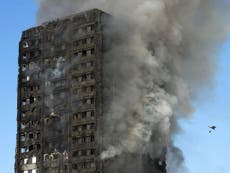There are 1,399 homes a stone's throw from Grenfell Tower left empty by millionaires. Time to move in the victims
There is a horrible possibility that the victims of this tragedy will lose their home twice over, if they are found new homes outside the borough of Kensington and Chelsea
Last night the former residents of Grenfell Tower lay crowded together on mix-and-match donated blankets and cushions, staring at the rafters of the sports centre in which they tried to slept. A stone’s throw away, 1,399 properties sat in silence; darkness fell over large airy rooms, their blinds unopened for months. These homes – if that’s what you charitably want to call them – are investment “nest eggs” worth £664m, and they are empty. None of them have been opened up to the displaced residents of the Grenfell Tower fire.
In fact, the very existence of these houses probably means that the residents will be housed outside of the borough of Kensington and Chelsea. There is a horrible possibility that the victims of this tragedy will lose their home twice over.
London has the second most over-valued property market in the world, in large part because of the increased demand from those who treat property solely as profit. Returns on house-price growth consistently outperform the stock market and other investment portfolios, meaning homes are bought, left empty, or sometimes let out, and then sold for a significant profit just years – or sometimes mere months – later.
The demand from speculative buying means that the cost of a terraced house in Kensington and Chelsea is £4.3m – the highest anywhere in the country. This has had serious consequences for the borough’s social-housing stock. As a result of the 2015 Housing and Planning Bill, Kensington has been forced to begin the process of selling low-profit assets in high value areas to fund the extension of Right to Buy, further reducing low-cost housing options.
In short, the high house prices in the borough mean that the majority of council properties are eligible to be sold off. More expensive empty homes means less council housing. Under the plans Kensington was predicted to lose 97 per cent of its social-housing stock. According to the council’s 2013/17 housing strategy, the borough is “looking at the potential benefits of selling a limited number of high-value properties”.
No homes will be built in their place, partly because much of the revenue raised to build new homes in the area is likely to be funnelled into discounting home ownership. This means less local places to house residents in need of low cost homes – including those who now find themselves without a roof or any of their possessions following the Grenfell Tower fire.
Waiting lists are soaring and for those who need emergency temporary accommodation there are few options. Kensington has been unable to even pay for temporary accommodation for their most vulnerable residents and have been forced to house them not only outside their borough, but outside of London.
What will the borough do now, faced with hundreds of new homeless residents? Will it, true to form, send them outside of the borough, away from their friends and their family during a time of unimaginable grief and loss? Or will it make a call for all of those empty investment properties, sitting unused, to be made a home of?
Listen to author Kirsty Major discuss how Tory austerity led to the Grenfell Fire with Abi Wilkinson on the Indy Voices podcast Double Take.




Join our commenting forum
Join thought-provoking conversations, follow other Independent readers and see their replies